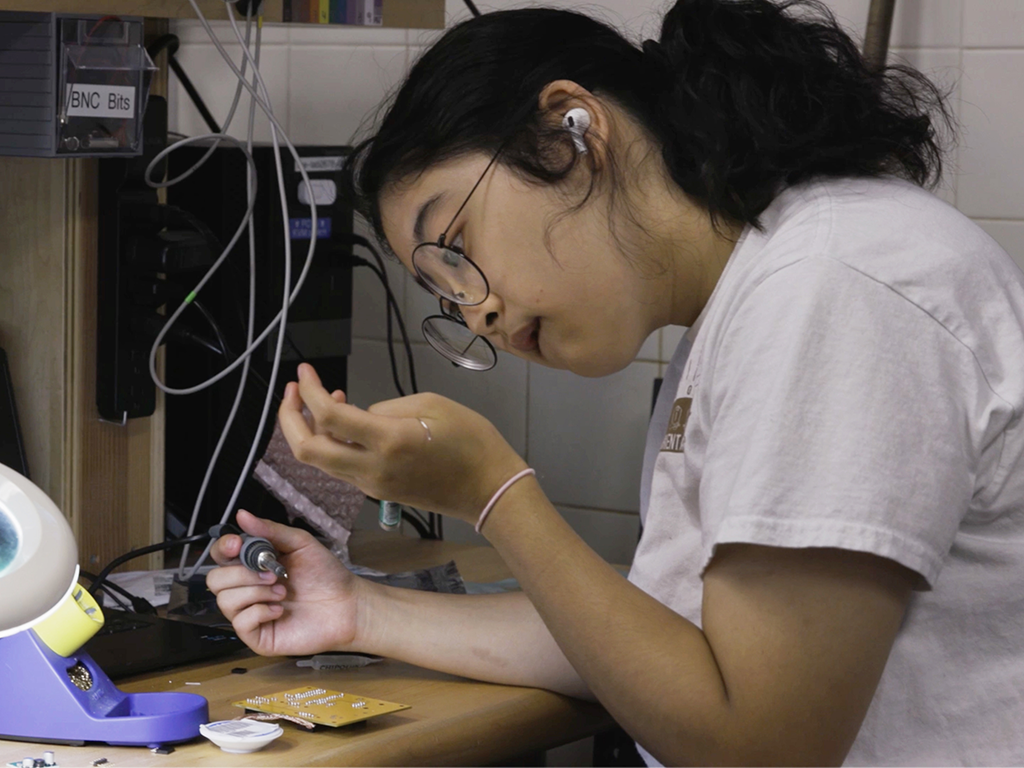Imagine it, Build it
In 2.679 (Electronics for Mechanical Systems II), a hands-on approach teaches problem solving
2.679 (Electronics for Mechanical Systems II) takes students through the process of design, fabrication, and assembly of a printed circuit board (PCB). That process, which has twists and turns depending on each student’s project idea, culminates in the incorporation of the PCB into a device — in a sense animating that device to perform a certain function.
“The design intent of 2.679 is to empower students to ‘imagine it, build it,’” says Tonio Buonassisi, professor of mechanical engineering. “Between those two is a universe, and the purpose of this class is to aid aspiring engineers to bridge that gap.”
 MechE undergraduate Jessica Lam works on her design in the lab. Credit: Lauren Futami SM ’22
MechE undergraduate Jessica Lam works on her design in the lab. Credit: Lauren Futami SM ’22Students say the course offers a sort of alchemy that transforms students from consumers of knowledge to explorers and innovators, and equips them with a range of important new tools at their disposal. Jessica Lam ’24 marvels at how much she learned in the course over its one short semester.
“I’ve found that in a lot of other labs and project-based classes, they throw a lot of information at you at once with the expectation that you already have some experience with certain software or hardware and most of it is scaffolded and feels like a black box,” without much understanding of what is actually happening, Lam says. “[Technical instructor] Steve Banzaert has a better understanding of what we already know and how to build on that.”
The course left Lam feeling “a lot more confident in designing electrical systems,” and with “a more comprehensive understanding of how to integrate mechanical systems and electronics.” Which is by design – Banzaert says the class guides students along their own chosen paths of discovery, showing them that they are able to address the challenges they encounter along the way.
“Every semester we get to see really lovely examples of growth, not just in the course material but, in the best cases, in students’ understanding of what they’re really capable of,” he says.
“We try to make it very clear that, yes, we are talking about important general concepts in theory and analysis, but that’s because they are tools that engineers use to solve problems. I think maybe this focus helps remind the students of what got them here in the first place — that the reason you’re an engineer is because there’s something about the world you wish was better, that you’re the person to do it (or at least help), and, if you want to do it well, you’re going to have to learn a bunch of things so you have more tools in your toolbox.”
Yasin Hamed ’24 designed a car that uses computer vision to follow along a black line. The car has an attached camera that captures images and relays them to a Raspberry Pi computer that is also attached to the car. Processing the images in real time allows the car to locate the black line and turn or go straight while controlling the car’s speed. Hamed had built a similar system in a previous class, but he says the focus in that class was on software. With his 2.679 project, he learned about the underlying foundation.
“I derived much of the ‘enlightenment’ from this class from the little electronic bits and pieces of information I picked up along the course of the class, like learning/practicing soldering, understand how to use integrated circuits, learning how to design a PCB, etc.,” he says. “It was the collection of all of these things that benefitted me the most.”
Jordan Parker-Ashe ’24 appreciated how 2.679 combined lessons about electronics with research and presentations from Buonassisi’s lab. “It’s great seeing engineering applied in research,” she says, adding that the class opened up a whole new field to her, with Banzaert having “directly inspired” her to also take 6.131 (Power Electronics).
“2.679 helped me believe in myself, which inspired me to take 6.131, a notorious electrical engineering capstone, which has made me realize that my future lies as a nuclear-electrical engineering engineer, not just a nuclear engineer,” Parker-Ashe says. “It’s opened the doors to very rich landscapes for project ideas, creating explorations, art… I’m so glad that I’ve been able to find opportunities in Course 2 that helped give me hands-on, applied engineering experience.”